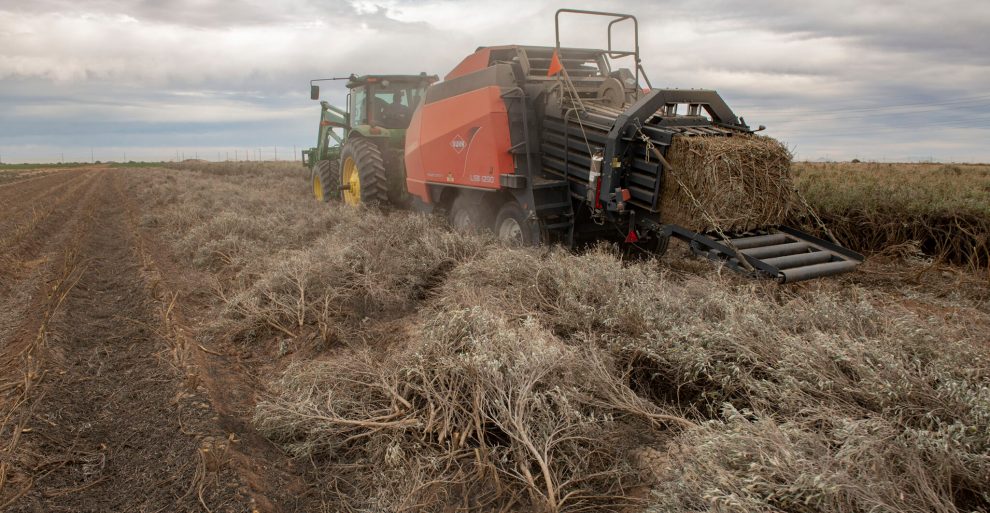
Paul Sanchez drives the custom guayule bailer from the Bridgestone Guayule Research Farm to harvest a field of guayule on a test field outside Stanfield, Arizona. The bailer is designed to cut through the woody stem of the guayule plant that would otherwise destroy a traditional bailer. Bill Hatcher
This story was originally published by The Food and Environment Reporting Network and is reproduced here as part of the Climate Desk collaboration.
On a spring day that would have seemed abnormally hot anywhere else, I went rumbling down dirt roads south of Phoenix in search of an answer to a question that had been dogging me. The West is mired in a water crisis that’s difficult to fully comprehend. More than 40 million people in seven states and two countries depend on the Colorado River, and its waters are depleting at a terrifying rate. Since the 1900s, flows have decreased by 20 percent, a drop largely associated with climate change. Experts say the situation will only get worse.
Outside Eloy, I drove past miles of empty fields riddled with Land for Sale signs. These farms had been hit hard by recent cutbacks in the delivery of Colorado River water, upon which they had relied since the 1980s. Those who were still in the game were scraping by and bracing for more rationing. Eventually, I came to a chain-link gate with a warning: “Watch out for snakes.” Behind it, I found a 300-acre desert laboratory operated by the Japanese-owned Bridgestone Corporation where a small team was toiling away, in some sense, on the same question.
The compound was nothing like the farms of fluffy cotton and bright green alfalfa I was used to seeing in central Arizona. A ring of barbed wire contained a stucco building with offices, meeting rooms, and a greenhouse where geneticists in white coats peered through microscopes. Out back, rows of ragged shrubs grew at varying heights. This was guayule (pronounced why-oo-lee), a plant native to Southwestern deserts that happens to produce latex. From this unassuming outpost, Bridgestone was trying to establish the country’s sole domestic source for the kind of high-grade natural rubber used in airplane tires and surgical gloves—and they were doing it with a crop accustomed to drought.
“This is a big investment,” said Dave Dierig, the farm’s trim and stoic manager, though he stopped short of naming a number.
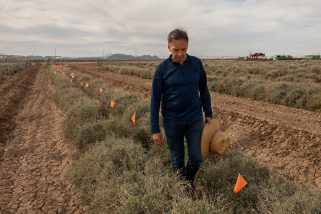
Dr. David Dierig walks along a row of guayule plants at the Bridgestone Guayule Research Farm.
Bill Hatcher
The company intends to disrupt a supply line that has for more than a century been milking rubber from musty tropical forests and shift it to the middle of the searing desert. To succeed, this laboratory will have to develop a wundercrop that produces high rubber yields with relatively minuscule amounts of water. But that’s just the start. Bridgestone will also have to develop guayule-specific farm equipment and convince Arizona’s farmers—who cling proudly to their role in providing food and fiber for American families—to produce something that can be neither eaten nor worn. Many companies and the US government have already tried and failed.
“You can’t do it and make a buck. Good luck to the guy who says he can. But I think he’s dreaming,” Goodyear spokesman Hank Inman told the Los Angeles Times in 1988, the same year his company threw in the towel on its own guayule scheme.
And yet Dierig, who is also a plant breeder, was adamant that this time would be different. Bridgestone produced the first tires made entirely of guayule rubber back in 2015, and a couple years later received a $15 million grant from the USDA to continue its research. In 2021, the company announced an extension of those laboratory experiments, a breakthrough in its genetic research, and a commitment to opening a commercial processing facility in Arizona by 2026.
Squinting across a sea of teal shrubs, I thought: This is what adaptation to climate change looks like in Arizona. While coastal cities erect seawalls, river towns construct wetlands to absorb floods, and Californians thin their forests of tinder, desert farmers search for a crop that can survive 114-degree days on less than four inches of rain a year and still throw off enough cash to run their air conditioning.
And if this crop wasn’t it, well, then understanding exactly why might still help thousands of farmers—and the agriculture industry as a whole—carve a path toward sustainability in the desert.
Dierig bent over a guayule bush, tore off a woody stem, and showed me the dense hairs and waxy coating that keep moisture from escaping its leaflets. “There’s no other crop like guayule,” he explained. “It’s a true desert shrub” that just happens to produce latex. Beneath our feet, the densely planted shrubs sent their taproots 20 feet down toward moisture, a trick that allows them to survive prolonged periods without rain. Guayule needs about 3.5 acre feet of water each year (an acre foot is enough to cover one acre of land a foot deep), which is at least half a foot less than cotton and nearly two feet less than alfalfa. Dierig’s team is working to shave off another six inches while also increasing yield.
A thousand years ago, people indigenous to the Sonoran Desert chewed the shrub’s stems to release their latex and collected it in balls they might have played with. Archeologists found one of those at a dig just a few miles away. Considering that latex accounts for little more than 8 percent of the plant’s total biomass, it is astonishing that, within the hundred or so acres of guayule spread out before us, we were looking at enough rubber to make about 1,000 tires.
There are hundreds of plants that produce rubber, most likely as a defense against disease or parasites, but just a few that produce the kind of rubber needed to make tires and high-grade latex. Of those, guayule is the only plant adapted to arid environments. Today, about 90 percent of America’s natural rubber comes from hevea trees planted across some 27,000 square miles in Southeast Asia, accounting for three quarters of the world’s total production. This concentration exposes global stocks to disease and U.S. companies to market fluctuations. It’s not surprising, then, that Americans have been trying to drum up a domestic supply for some time.
In the 1920s a blight hit Brazil’s hevea tree plantations and the U.S. government started growing guayule, but it soon gave up the effort. In 1940, when Japan invaded Indochina and blocked access to that region’s hevea, the U.S. government planted about 30,000 acres of guayule, then burned 21 million pounds of it when the war ended and it became clear that tapping foreign stocks was far easier, in the short term, than establishing a domestic supply. Thirty years later, during the Arab oil embargo, the U.S. gave the shrub another abbreviated attempt in search of synthetic polymers. On each occasion, guayule projects were abandoned in favor of other more attractive crops or as soon as the price of imported rubber dropped. Sustainable production never took root.
Now, Bridgestone has made significant genetic breakthroughs and desert farmers are more desperate than ever for a way to stay in business. Might things be different this time around?
Rimjhim Aggarwal, a sustainability researcher at Arizona State University, told me that the region hasn’t taken alternatives seriously in the past. “Now that the water restrictions are here, I think we need to look deeper into other options,” she said. And in light of the food shortages seen in Phoenix during the pandemic, Aggarwal said it’s critical that agriculture doesn’t disappear from the central valley. Even if you can’t eat it, guayule is a high-value crop with a buyer in the wings, and it might provide a cash stream that keeps farmland in production.
In August of 2021, the U.S. Bureau of Reclamation announced the long-dreaded news: Cutbacks of Colorado River water were necessary to avert a larger catastrophe, and thanks to a byzantine web of 20th-century water laws, and a running list of court decisions and backdoor agreements, hundreds of farmers in central Arizona had drawn short straws. In 2023, this sliver of the state’s $23-billion agriculture industry would lose its entire allotment of river water.
The farmers knew this was coming. Those who haven’t sold out are fallowing (leaving unplanted) as much as 40 percent of their fields. Some have invested in drip irrigation systems, high-tech field moisture monitoring, and less-thirsty varieties of staple crops. Many more are, for the first time in decades, pumping groundwater—with limitations—from already stressed aquifers. And a few have even tried planting alternatives like barley and hemp. But so far, no new crop has lived up to its boosters’ hype, and most growers are sticking with what they know, as long as the water flows.
“There’s no point in growing something you can’t sell,” said Gary Deen, and he should know. From silver mining to cotton farming, Deen’s family has cashed in on some of rural Arizona’s most lucrative industries. I met him at the entrance to his 400-acre farm beneath a tree filled with so many warbling meadowlarks that I could hardly hear him recap the past hundred years of the state’s economic evolution.
Deen began growing Bridgestone’s guayule in 2015, but he hasn’t yet uprooted his wheat, cotton, or hay. The company planted 40 acres of its experimental crop on his land, managed the weeds, harvested the shrub, and paid him for the yield as if it were cotton. Bridgestone has been careful about setting farmer expectations too high, though.
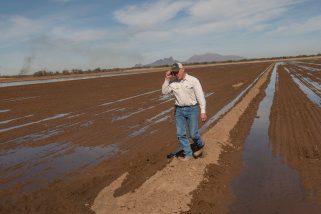
Farmer Gary Deen walks a flooded irrigated field in Eloy, Arizona, where he once grew guayule that is being prepared for a cotton crop.
Bill Hatcher
Past attempts put the cart before the horse, Dierig said. They gave experimental seeds to farmers prior to ensuring a long-term market. Now, working from seeds preserved at a national seed bank in Colorado and with two additional proprietary varieties, his team has mapped the DNA of different guayule strains to identify and select for traits like drought tolerance and the highest yield. Bridgestone also grows shrubs at satellite outposts to find varieties that can withstand frigid winters in upper elevations, since guayule takes two years to mature and the company intends to grow in Texas, California, and Mexico.
While Deen showed me around his farm, a custom-made prototype baler tore through a field of the stuff, which looked like an unruly weed beside his rows of orderly wheat. Guayule’s woody stems easily throttle conventional balers, so Bridgestone is also developing new harvesting equipment tailored to the shrub. Even the seeds, which are five times smaller than rice, needed a special wax coating to keep them from glomming together during planting.
Bridgestone has navigated these upfront hurdles because it sees so much potential on the back end, Dierig said at his laboratory. Domestic production will reduce the $1.4 billion a year that’s currently spent importing natural rubber to the U.S. But tires are just part of the picture. Bridgestone is building an ecosystem of markets, which includes the largest chemical company in Italy, to ensure farmers have plenty of reasons to grow lots of guayule.
Once completed, its new Arizona processing facility will be able to transform 1,000 tons of biomass daily into multiple high-value products, including latex for use in hypoallergenic surgical gloves (a $28-billion global industry), resin for use in adhesives, binders for asphalt, and terpenes for insecticides. Once these chemical compounds are separated, the remaining woody fibers, which account for about 80 percent of a shrub’s total mass, will end up as biofuel.
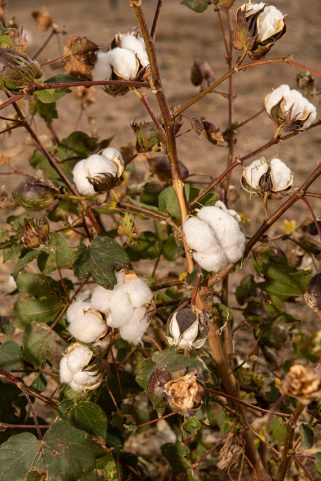
A cotton plant outside Eloy, Arizona a town in Southern Arizona that was almost renamed Cotton City in the early 1900’s.
Bill Hatcher
For Deen, whose arrangement with Bridgestone ended after the company switched to using farmland closer to the desert lab, the best part of the deal was getting paid up front. That level of certainty is rare in a world where crop prices fluctuate and acts of God seem to be happening more often. Still, Bridgestone is scrambling to enlist enough growers.
“We’re paying a premium because we’re new,” Dierig said, but the company expects guayule to soon stand on its own—no premium, and no support for cultivation and harvest. To meet and sustain his commercial production goals, Dierig needs to have 10,000 acres in the ground by 2024 and another 10,000 acres the next year. There are only about 200 acres planted now.
“If we could find a crop that’s a low-water user, like guayule, that we can make money on, year in and year out, we’re going to be all over it,” said Dan Thelander, an elder statesman of Arizona agriculture whose family grows on about 5,000 acres in the central valley. They will plant around 40 acres for Bridgestone this spring.
Said Thelander, who has been involved in discussions of water shortages for years, “Everybody’s feeling the pain, but I can tell you that agriculture in Pinal County is gonna feel a lot more pain than anyone else.” As farmers fallow land, he explained, “there will be more laborers not getting paychecks; then they’re not buying things in stores—the fertilizer, the seed, the pesticide, the tractors, equipment, and repair.” A crop like guayule might lessen the strain on farmers and also buoy this weary community.
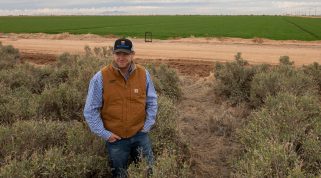
Farmer Will Thelander stands in a field of guayule south of Phoenix, Arizona.
Bill Hatcher
The Thelanders could handle 1,000 acres of guayule, but Dierig wants to keep initial production spread across many small parcels to hedge his bets against the region’s patchy rainfall patterns. That means winning buy-in from a small army of farmers accustomed, over the generations, to growing either cotton or hay, which they steadily sell to local dairies and ranchers, or to overseas customers who pay set rates for cheap grass.
Dierig and his team give presentations at Bridgestone’s farm to win new converts, and they’ve garnered a commitment from the Gila River Indian Community, whose tribal growers are entitled to more Colorado River water than any other central valley farmers. Cropping decisions are often determined by tradition, however, which puts guayule at a distinct disadvantage.
When Eloy was established, in 1918, locals lobbied to name it “Cotton City.” A century later, the lucrative crop is still a winner: in 2019, farmers planted 85,500 acres of cotton in Pinal County, bringing in $92 million in revenue. Pinal ranks 10th among the nation’s cotton-growing counties. At his farm’s office, Deen proudly displayed a fibrous cotton tuft atop a hunk of silver ore. This cultural inclination presents an obstacle for Bridgestone, but so do the economics.
Tractors, fuel, seed, fertilizer, water—everything has grown more expensive lately, but land most of all. Thanks to Arizona’s fervent drive to build tract housing and strip malls, its average price of cropland, at $7,700 an acre, surpasses that of all Mountain West states (Idaho is a distant second at $4,450 an acre). And because most central Arizona farmers lease rather than own the land they grow on, many are hesitant to take risks that might delay their rent payments, especially with developers circling the perimeters, licking their chops. That said, as long as Bridgestone is paying cotton prices and guayule uses less water than cotton, farmers could grow more guayule than cotton on what water they have and make more money.
But it’s not that simple.
Pinal farmers also receive more federal funding than do farmers in any other Arizona county, and water-loving cotton is more heavily subsidized than any other crop in the state. Nationwide since the early 2000s, direct subsidies—paid at a set rate every year regardless of conditions—have largely been replaced by federally funded (and taxpayer supported) crop insurance payments, which compensate farmers if they experience a loss in crop yield or a decline in revenue. From 2000 to 2020, crop insurance paid to Pinal farmers rose from $3.2 million to $24.6 million, according to data collected by the Environmental Working Group. Three quarters of that money was paid to cotton growers to cover their losses, and half of those losses were caused by a “failure of irrigation supply.”
Might this government support nudge a farmer toward sticking with water-intensive cotton despite the extreme drought?
“Crop insurance is not intended to discourage or encourage the plantings of specific crops, but is simply there as a tool for growers of these crops,” explained Jeff Yasui, the USDA’s director of risk management for the Southwest. “The availability of the program does not consider water issues or the disbursement of subsidies.”
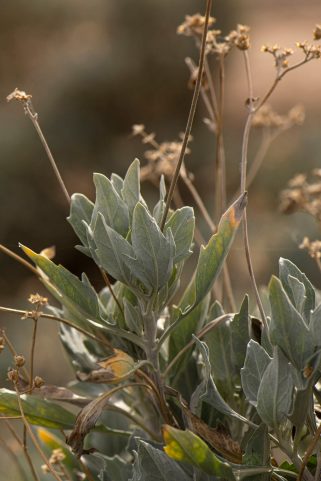
Leaves and dry flower stalks of guayule plants at the Bridgestone Guayule Research Farm in Eloy, Arizona.
Bill Hatcher
In recent papers, however, agricultural economists have argued that the USDA’s crop insurance program disincentivizes experimentation with measures that might help farmers adapt to climate change. Even programs that encourage climate-smart tactics, like planting cover crops, can be less lucrative than insurance claims. Last year, Stanford University researchers reported that 14 percent of the $140 billion in crop insurance paid to farmers between 1991 and 2017 could be attributed to losses associated with temperature increases.
If the government is serious about helping desert farmers adapt to drought, it might invest as much in adaptation as it does in subsidizing the status quo. In the latest Farm Bill, the USDA provided support for some projects aimed at climate adaptation—like the $15 million Bridgestone received to help with research—and President Biden’s infrastructure bill earmarked more than $8 billion to update and augment water infrastructure in the West. But once Bridgestone stops paying its current premium, there will be little incentive for farmers who want to swap bags of cotton seeds for tiny grains of guayule.
I didn’t expect to find a silver bullet for the West’s water crisis at Bridgestone’s desert laboratory, and I didn’t. Clearly, guayule has enormous potential, otherwise the tire company, the US government, public universities, and so many others wouldn’t bother with it. It’s also true that Arizona’s farmers are heavily invested in crops that make little sense in a landscape facing megadrought. But decades of dam building, canal laying, deal striking, and subsidy paying have made the desert hospitable enough. And 300 days of sun make it a hell of a place to grow just about anything, anyway.
As one farmer explained after a long day of harvesting hay, “We have so many more costs here, but we can produce better yields per acre, and we can produce better quality because of our climate. If I was a supreme ruler of the world, there wouldn’t be anybody living in this goddamn state except farmers and ranchers.”
In the cities and suburbs, I’ve met many who would similarly like to have Arizona to themselves. For the time being, though, we all have to share it. And as long as that’s the case, we’d be better off designing a sustainable future together rather than holding our breath until the water runs out.
This article was supported by The Water Desk at the Center for Environmental Journalism, University of Colorado Boulder.














